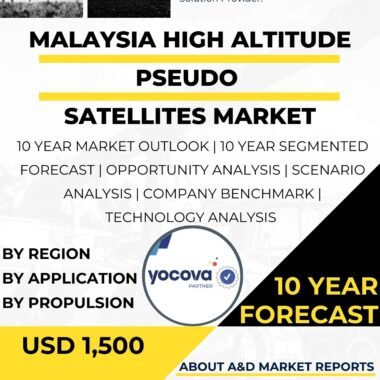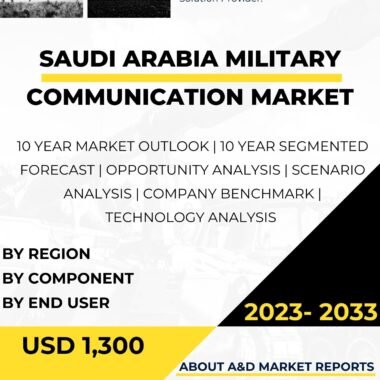Description
Tactical Video Data Link market in Sweden is a dynamic and evolving segment of the defense communication sector, driven by the increasing need for secure, real-time visual data sharing across various military platforms. As modern military operations become more network-centric and rely heavily on integrated battle networks, the facilitation of live high-definition video feeds and sensor data between airborne, ground, and naval assets plays a critical role in enhancing situational awareness and operational effectiveness. This market is pivotal in enabling commanders and field operators to visualize live battlefield conditions, which is essential for informed decision-making, dynamic mission coordination, and minimizing risks such as friendly fire incidents.
In Sweden, the defense sector has shown growing interest and investment in tactical video data link technologies, reflecting broader global trends towards multi-domain operations and integrated battlefield networks. The demand is fueled by the expanding use of unmanned aerial vehicles (UAVs), tactical ground vehicles, naval platforms, and manned aircraft that require seamless, low-latency video transmission to maintain operational tempo and improve intelligence sharing. Technological advancements have significantly improved the capabilities of these systems, with innovations in wireless transmission protocols, multi-band frequency agility, and state-of-the-art encryption ensuring secure and resilient communications even in contested or electronically cluttered environments.
The Swedish market benefits from the development of compact, modular hardware designed to fit various platforms without compromising performance. This hardware integration flexibility is critical given Sweden’s diverse defense assets that operate across challenging terrains and maritime domains. The rise of artificial intelligence has also permeated tactical video data links by enabling real-time image analysis, threat recognition, and bandwidth optimization, which are essential for enhancing the clarity and utility of transmitted data streams during complex military operations.
Strong factors driving the Swedish market include the heightened emphasis on real-time situational awareness and the need for interoperability with allied forces, especially within multinational coalition operations. Sweden?s participation in joint exercises and its alignment with network-centric warfare doctrines underscore the necessity for standardized, secure video communication channels. These collaboration efforts push the demand for systems that ensure seamless integration of video data across different defense platforms and command centers.
Security concerns and electronic warfare threats further stimulate the need for advanced tactical video data links equipped with sophisticated encryption and anti-jamming features. The ability to maintain secure communication channels in the face of cyber and electronic warfare attacks is crucial for safeguarding sensitive visual intelligence and ensuring mission success. Additionally, the incorporation of satellite communication technology extends operational reach beyond line-of-sight, which is vital for Sweden?s defense forces operating in expansive and remote regions.
Economic and strategic factors also contribute to market momentum. Sweden?s defense budget allocations reflect a commitment to modernizing communication networks and supporting next-generation defense technologies, including tactical video data links. The procurement focus is on solutions that enhance command and control capabilities, promote faster and more accurate decision-making, and improve coordination across various military branches. This focus aligns with global trends that emphasize real-time data exchange, interoperability, and network security in defense communication systems.
Moreover, the Swedish market is influenced by the increasing deployment of unmanned systems, such as drones, which rely heavily on high-quality video feeds for reconnaissance, surveillance, and targeting purposes. Tactical video data links thus play a critical enabling role in ensuring these unmanned platforms can transmit real-time visuals efficiently, helping to enhance battlefield transparency and operational agility.
The evolving defense landscape in Sweden also pushes innovation in tactical video data link systems toward greater compactness and reduced size, weight, and power consumption, a trend that makes them more adaptable to a wider range of platforms. This trend is particularly relevant for aerial drones and smaller ground vehicles where payload capacity and endurance are critical factors. Real-time data analytics capabilities integrated into these systems contribute to faster threat detection and response, reinforcing operational effectiveness.
All these elements create a robust environment for the growth and development of the tactical video data link market within Sweden. The market is characterized by continuous technological advancements, strategic procurement policies, and an operational need for greater situational awareness through real-time video data. The result is a highly focused effort to deploy secure, reliable, and interoperable video communication networks that can operate effectively in challenging and electronically contested conditions.
In conclusion, the Tactical Video Data Link market in Sweden is shaped by the convergence of advanced technologies, increasing defense modernization efforts, and the critical requirement for real-time visual data exchange across multi-domain battle networks. This market is essential for supporting Sweden?s defense capabilities, ensuring interoperability with allied forces, and advancing the country’s operational command and control infrastructure in both national and coalition contexts. The integration of artificial intelligence, encryption, satellite communication, and modular hardware design continues to drive the sophistication and adoption of tactical video data link systems, enabling Sweden?s defense forces to maintain a technological edge in modern warfare environments.




